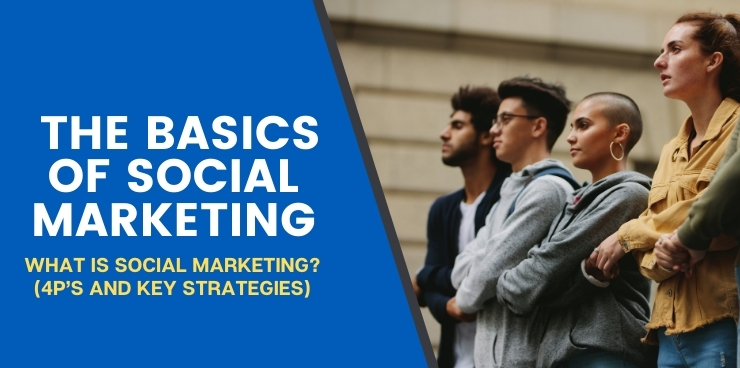Getting a convincing message across to the modern free-market consumer takes creativity no matter who you are. Marketers have to be the best at grabbing attention and communicating value to beat the competition and win business.
Profit-driven companies are not the only ones who need to outmatch their competition to sell their product. Even organizations whose singular goal is to benefit individuals and society as a whole need to make compelling arguments. Whether it is local anti-drug efforts or national voting rights campaigns, marketers need thoughtful strategies to achieve their goals.
Marketing for good assumes many of the same challenges as marketing for profit. Human interest organizations and public servants need to persuade their audience to take a particular action. They must research, develop and communicate value to beat the alternative. This is the basis of social marketing.
What is Social Marketing?
The goal of social marketing campaigns is to drive social change. It borrows commercial marketing models to inspire public action and achieve specific goals. Rather than trying to convince audiences to buy a product, it focuses on selling positive behaviors. The objective is not to benefit an organization’s growth but rather the good of society.
Unlike commercial marketing, social marketing is always action-based. Companies often take soft approaches to introduce ideas related to their brand to affect consumer interest, attitudes or beliefs. A business may try to shift perceptions with campaigns, associating their brand with particular ideas without employing specific calls to action. Social marketing ads are never solely aimed at raising awareness or changing opinions — the objective is a public action. They bring light to a public problem or threat and say, “To solve this public problem, do this.”
Social marketing is used in a number of public interest areas, including the following:
-
Health and Safety
-
-
- Anti-drugs.
- COVID vaccinations and mask-wearing.
- Wearing a seatbelt.
-
-
Social Activism
-
-
- LGBTQ+ campaigns.
- Fighting racial inequality.
- Human rights.
-
-
Environmental Causes
-
-
- Going green.
- Anti-littering.
- Recycling.
-
Most social marketing campaigns are created and managed by nonprofits or charities fighting for their causes. Government institutions such as police departments, emergency services and health divisions run public safety initiatives as well. Social marketers employ the same commercial marketing channels to promote their messages, including TV ads, digital marketing and billboards.
The Importance of Social Marketing
Consumers need a reason to buy. There has to be an appeal to their needs and a connection to their values. The message needs to be attention-grabbing and inspiring. If a marketing communication is simply “Buckle Up”, there is no inherent purpose that benefits the consumer. The message will most likely be lost.
The basis of social marketing is similar to commercial marketing, and that’s why applying similar principles is so critical. Businesses try to earn a customer’s money, and social marketing campaigns seek to earn their behavior change. In exchange, you do not receive a product but rather some benefit to society. The target audience would have to see greater value in the benefit than in the cost.
Sometimes raising awareness is enough to inspire change. People simply might not be aware of a problem or how they are contributing to it. Other times, they may be aware but find the desired behavior too demanding or see little benefit. Effective social marketing requires creative, compelling messages to engage consumers and touch them emotionally, motivating them to act.
The Misconceptions of Social Marketing
The central focus of social marketing is promoting social good. In many cases, commercial campaigns can be mistaken for social marketing. So, it is important to understand distinctions in their efforts.
Social Media Marketing
Similar in name and little else, social media marketing is any marketing that uses social media platforms. This is a critical component of commercial marketing strategies. Social media ads and messaging on Facebook, Twitter and other platforms are used to sell brands, products or services. Companies may tie in social messaging or initiatives but the purpose is more to promote themselves.
Cause-Related Marketing or Marketing with a Social Focus
Cause-related marketing involves a collaboration between a business and a nonprofit or charity to promote both entities. American Express first used this in 1983 when promoting the Statue of Liberty’s restoration. It brought light to a social issue but also benefited American Express’s brand image. Social marketing only promotes the social issue.
Sometimes the business promotes a social belief without working with a nonprofit. For example, Pepsi’s hamfisted attempt at addressing racial inequality with Kendall Jenner may seem like social marketing. However, the campaign’s objective was focused more on positioning Pepsi’s brand to appeal to its target audience.
Sustainable Marketing
Companies use marketing to promote their corporate social responsibility. They may produce ads to talk about major philanthropic contributions or charity work they perform. Unlike social marketing, audiences are not asked to change behaviors but instead to view the company more favorably.
“Tie-in” Product Marketing
In some cases, brands try to make buying their product a positive consumer behavior to benefit society. Electric vehicles are promoted to reduce fossil fuels. A potato chip manufacturer may highlight its recycled packaging. Other companies, like TOMS, make charitable donations with every purchase. Although this type of marketing does imply real societal benefit, the primary focus is still on selling a company’s product.
Social marketing takes the brand out of the message. The only call to action is to develop healthy behaviors to better society.
 The 4 Ps of Social Marketing
The 4 Ps of Social Marketing
Social marketing, like commercial marketing, requires a focus on the target audience. Marketers need a deep understanding of the consumer’s needs, pain points, challenges and desires. In designing social marketing campaigns, these factors influence the 4 Ps of the marketing mix — product, price, place and promotion.
With better consumer insight, marketers can define the 4 Ps to make customers more able and willing to act.
Product
In social marketing, “product” is the desired behavior and the social benefit stemming from it. For instance, an anti-drug campaign is selling improved public health as the product.
Present the product as the best solution to a real problem. Problems can be approached from logical or emotional angles. An anti-smoking ad could cite annual deaths related to cigarette use to showcase the scope of the problem. Alternatively, they could have a spokesperson to discuss the loss of a loved one to create an emotional connection.
Marketers need to have an acute awareness of how consumers perceive the problem. In doing so, they can frame the behavior in an appealing fashion. This can be done to either position the behavior as positive or the opposite behavior as negative. In the anti-smoking example, statistics could be used to make positive arguments that deaths can be reduced with good behaviors. Discussing personal loss, however, looks at the negative, what is at risk if behaviors do not change.
Price
The price in social marketing is what it will cost the customer to earn the social benefit. In many cases, especially for charities, this is monetary. An advertisement might ask for contributions to help feed the hungry, provide disaster relief or sponsor a child.
The price may also involve a person’s time, effort or comfort. Certain behaviors are less costly than others. Remembering to wear a seatbelt is an easier change for many than quitting smoking after several years.
Ensuring the benefits outweigh the price is crucial to sell the behavior. This can involve magnifying the perceived benefits, or it could entail reducing the price. In any social marketing campaign, keeping the price as minimal as possible is key to maximizing the adoption of the behavior.
Reducing price could be reducing money spent but it often involves finding ways to save time and effort. For instance, a recycling campaign may suffer engagement because people have to sort their recyclables before drop-off. They could remove that obstacle by having workers sort them afterward, making it easier for the consumer.
Place
Place refers to where the consumer performs or thinks about the promoted action. Making these places conveniently accessible to the consumer heightens the chances of their participation. If you are trying to reduce littering in a park, placing garbage cans at regular points makes cooperation easier. If you are running a food drive, position stations at grocery store entrances to make it convenient to donate. Smart strategies surrounding “place” facilitate the consumer’s ability to act, eliminating barriers and reducing costs.
Promotion
Reach audiences through promotion to bring attention to social marketing efforts. It includes the various PR and advertising channels used to push messaging. This can involve social media advertisements, press releases to media outlets, special events or television spots.
Market research is critical at this stage to understand how the target audience can best receive information. Different target audiences consume different media. Marketers can waste valuable time and money directing messages at consumers who cannot, or will not, take action. Messages need the proper placement to receive the right attention and efficiently communicate meaningful benefits and clear, low-cost actions.
Tips and Strategies
How you craft each of the 4 Ps will determine the success of your social marketing campaign. To improve your results, follow these tips on creating more appealing offers:
Fine-Tuning “Price” Requires Adequate Research
Getting information from your audience about what could keep them from taking the desired action is crucial. Before developing the campaign, qualitative and quantitative audience research should be performed to uncover obstacles they face. It can take several rounds of market analysis to find the various physical and mental barriers that adequately constitute “price”.
When you know the price, you can start developing strategies and messages to minimize and overcome it. Holding focus groups and sending out qualitative surveys to gauge the effectiveness of those efforts can offer further insight. From there, you can craft impactful messaging and offer solutions that consistently overcome those hurdles.
Create a Memorable Slogan
The best social marketing campaigns center around a catchy slogan. Being able to communicate behaviors and value in succinct, easy-to-remember sayings make it more actionable.
In NY, “Click It or Ticket” was a simple rhyming reminder of the benefit of wearing a seatbelt. “Only you can prevent forest fires” is another famous slogan that can still resonate years after the campaign. The more creative the statement, the more it will rest at the ready in your audience’s minds.
 Prioritize Powerful Visuals
Prioritize Powerful Visuals
Creative imagery draws attention, surprising audiences and immersing them in the problems the campaign seeks to solve. The most powerful social marketing campaigns use the imagery in the places consumers contribute to the issue at hand. A campaign preventing drunk driving may stage an accident by a highway or use a 3D billboard. Organizations promoting plastic reduction can put creative visuals on plastic bags or bottles. These visuals make the problem more real for the customer and display their agency in producing change.
Try to Create a Unique Symbol
Like slogans, a simple but engaging symbol at the center of the campaign can carry significant meaning. Symbols can be characters, such as Smokey Bear, or abstract designs, such as the breast cancer awareness ribbon. In other instances, the symbol can become something tangible, like the “LiveStrong” bracelet. These are particularly effective because their use acts as advertising by itself, a constant and powerful reminder.
Social marketing holds a critical function in inspiring positive change for the benefit of society. Consumers need more than a blunt, logical argument to make necessary changes. They need a marketer’s appeal to emotion, with a problem framed as relevant, urgent and in their control.
When well-executed, social marketing generates action where there would otherwise be none. It unites individuals in causes greater than themselves and provides a feeling of true contribution and worth. If you want to learn how to empower your audience with social marketing, contact Selling Revolution today.


 The 4 Ps of Social Marketing
The 4 Ps of Social Marketing
 Prioritize Powerful Visuals
Prioritize Powerful Visuals